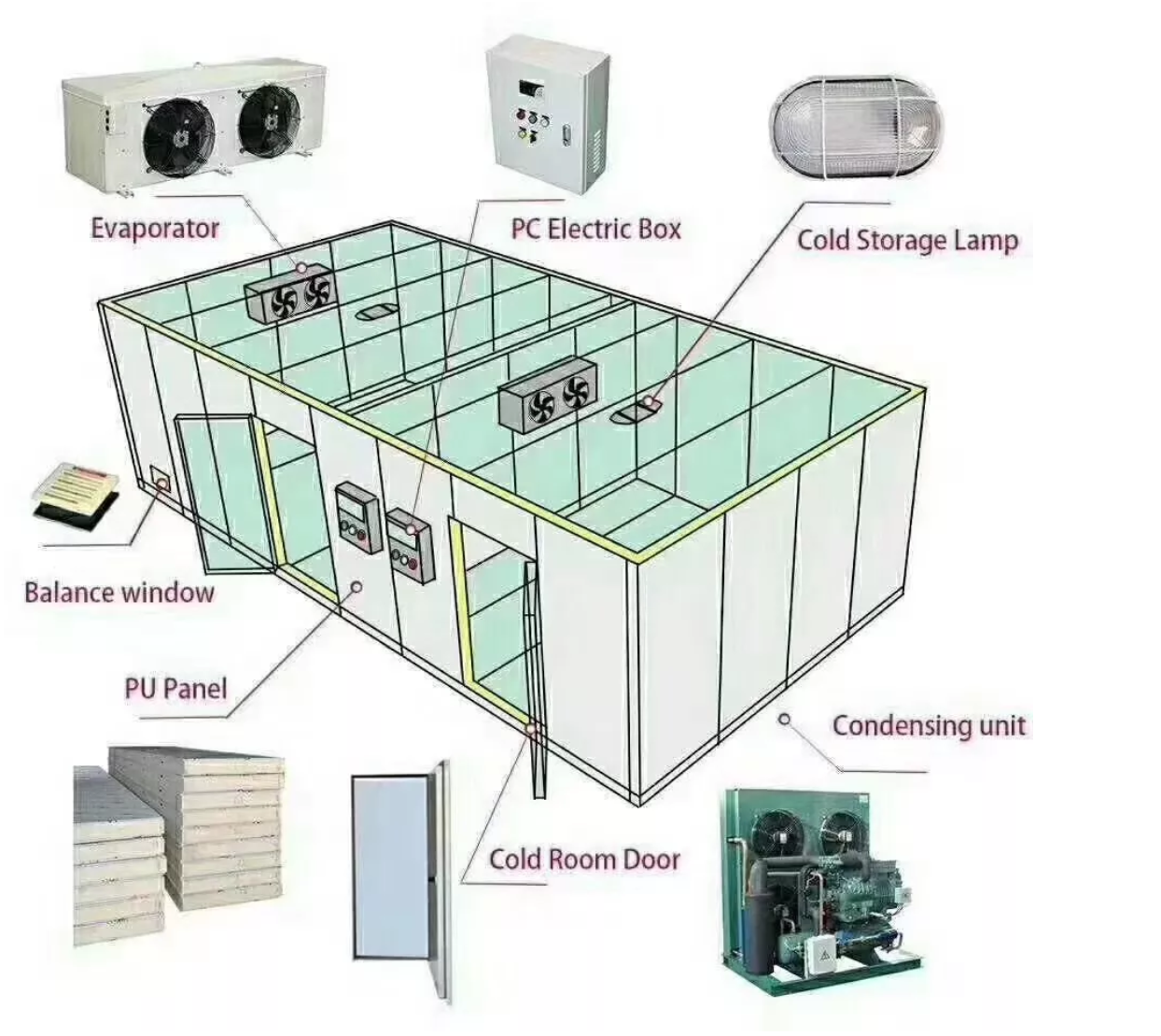Cold rooms are essential for storing perishable goods across various industries, from food to pharmaceuticals. But how do you design and build one that functions efficiently?
In this post, we'll walk you through the key steps in designing and building a cold room. You'll learn about essential materials, insulation, refrigeration systems, and installation tips to ensure optimal temperature control.
Planning Your Cold Room Design
Assessing Your Needs and Purpose
Before designing your cold room, it's crucial to assess what you'll be storing.
● What will you be storing? Are you storing food, pharmaceuticals, or chemicals? Each of these has specific temperature and humidity requirements.
● How long will items be stored? Consider whether your storage needs are short-term or long-term, as this will affect the cooling system and energy efficiency.
● Temperature requirements: Some products, like pharmaceuticals, may require stricter temperature control than others.
● Future scalability: Plan for growth. Will your cold room need to accommodate more items in the future? Ensuring that your design allows for capacity expansion is key.
Space and Size Requirements
The size and layout of your cold room depend on the type and volume of goods you plan to store. Here's how to plan:
● Estimating space needed: Consider the volume of the goods, whether they are stored on shelves, pallets, or hanging. This helps determine the floor space and height required.
Item Stored | Typical Storage Volume | Storage Type |
Meats | High volume | Pallet racking or shelving |
Pharmaceuticals | Low to medium volume | Shelving or controlled units |
Produce | Varies based on type | Shelving, crates, or bins |
● Planning for future capacity: Think about daily throughput and potential peak inventory during seasons or events. Design your space to handle increases in stock volume.
● Optimizing layout: The layout should focus on accessibility and workflow. Ensure aisles are wide enough for equipment and that shelves are arranged efficiently for easy access. Grouping similar items together helps streamline operations.
Layout Tip | Reason |
Wide aisles | Allow for easy movement and accessibility |
Grouping similar items | Improves efficiency and workflow |
Adjustable shelving | Allows flexibility for future changes in storage |

Key Considerations in Cold Room Design
Insulation: The Backbone of Temperature Control
The right insulation is crucial for maintaining the cold room's temperature and ensuring energy efficiency. Insulation reduces heat exchange, making the room more efficient.
● Materials: Common insulation materials include polyurethane, polystyrene, and mineral wool. Each offers different thermal resistance, so choose based on your room's needs.
● Thickness: For freezer rooms, thicker insulation (typically 150mm-200mm) is needed due to the low temperatures. Chiller rooms need thinner insulation (100mm-150mm) since the temperatures are higher.
Room Type | Insulation Thickness | Material Recommendations |
Freezer Room | 150mm to 200mm | Polyurethane or Polystyrene |
Chiller Room | 100mm to 150mm | Polystyrene or Mineral Wool |
Flooring and Structural Materials
Choosing the right flooring and structural materials ensures durability and safety in a cold room.
● Flooring Requirements: Use reinforced concrete for a sturdy foundation. For safety, choose non-slip surfaces to prevent accidents in slippery conditions.
● Moisture Resistance: The walls, floor, and ceiling should be made from moisture-resistant materials like stainless steel or fiberglass to prevent mold and degradation.
Material | Purpose |
Reinforced Concrete | Provides stability and support |
Non-Slip Surfaces | Prevents accidents in cold environments |
Moisture-Resistant Steel | Avoids mold and decay in cold areas |
Temperature Control and Refrigeration Systems
The refrigeration system is at the heart of your cold room's ability to maintain a stable environment.
● Refrigeration Components: The system typically includes compressors, evaporators, and condensers. Compressors cool the air, while evaporators distribute it evenly.
● Choosing the Right System: Select a system based on the room size and temperature needs. For large rooms, a centralized refrigeration system is more efficient, while split systems may be more practical for smaller spaces.
System Type | Best For | Energy Efficiency |
Centralized System | Large cold rooms | More efficient for big spaces |
Split System | Smaller cold rooms | Lower upfront costs |

Doors and Access Points
The doors of your cold room play a significant role in maintaining the desired temperature.
● Insulated, Sealed Doors: Doors should be well-sealed and insulated to prevent temperature fluctuations when opening or closing.
● Door Types: Depending on the space and usage, you may opt for hinged, sliding, or high-speed doors. High-speed doors are ideal for high-traffic areas, as they minimize heat exchange during frequent openings.
Door Type | Best For | Benefit |
Hinged Doors | Low to medium traffic | Simple and cost-effective |
Sliding Doors | Moderate traffic | Saves space and provides easy access |
High-Speed Doors | High-traffic areas | Reduces temperature loss, saves energy |
Building Your Cold Room – Step by Step
Site Preparation and Foundation
Before you begin building your cold room, it's important to properly prepare the site. Start by ensuring that the foundation is sturdy enough to support the weight of the cold room and its components.
● Utility Setup: Ensure that electricity and plumbing are in place. Cold rooms often require special power outlets for refrigeration systems, and you may need water connections for cleaning or humidity control systems.
● Location Considerations: Choose a location within the facility that optimizes both efficiency and energy usage. For example, placing the cold room near the main cooling unit or away from heat sources like machinery or direct sunlight can reduce energy consumption.
Preparation Step | Action | Benefit |
Foundation | Ensure proper weight-bearing and stability | Prevents shifting or sinking |
Utilities | Set up electricity, plumbing, and ventilation | Ensures smooth system operations |
Location | Optimize placement to reduce energy use | Minimizes energy loss |
Assembling the Components
Once the foundation is ready, it's time to assemble the components of your cold room.
● Panels and Insulation: Begin by placing the cold room panels. These panels should have the correct insulation to ensure temperature stability. Use polyurethane or polystyrene for effective thermal resistance.
● Sealing Joints: Ensure all insulation joints are sealed properly to prevent air leaks. Use vapor barriers to further protect the room from moisture buildup, which can damage both the room and stored products.
● Installing Doors: Doors must be well-sealed and insulated to prevent heat from entering when the door is opened. Use self-closing doors for added energy efficiency.
Component | Key Action | Purpose |
Cold Room Panels | Install panels and insulation | Maintain proper temperature |
Sealing Joints | Use proper sealing methods | Prevent air leak |
Cold Room Features and Functionalities
Lighting and Energy Efficiency
Lighting in a cold room isn't just about visibility—it's about energy efficiency too. For cold rooms, using LED lighting is highly recommended because:
● LED lights produce minimal heat, which helps maintain a stable temperature inside the cold room.
● These lights consume less energy compared to traditional bulbs, saving on electricity costs and enhancing overall energy efficiency.
When installing lighting, choose low heat-output LED lights designed for cold environments to avoid increasing the load on the refrigeration system.
Lighting Type | Benefits | Ideal Use |
LED Lighting | Low heat output, energy-efficient | Cold rooms, energy-sensitive areas |
Fluorescent Lighting | Slightly higher heat output | Not ideal for cold storage |
Humidity Control and Airflow
Humidity control is critical in cold rooms, especially for perishable goods. Excess moisture can cause spoilage, frost buildup, and damage to stored items like vegetables and meat. Here's how to manage it:
● Humidity regulation systems are essential to keep moisture levels within an optimal range. For example, fruits and vegetables require a higher humidity range than meats.
● Airflow management is equally important. Ensuring consistent airflow helps maintain temperature stability and prevents ice buildup on walls or products.
Proper airflow ensures that cool air circulates evenly, preventing temperature differences and frost accumulation.
Control Method | Benefit | Recommended Use |
Humidity Regulation | Maintains ideal moisture levels | Vegetables, dairy, flowers |
Airflow Management | Prevents temperature fluctuations and ice buildup | Meat, frozen food, pharmaceuticals |
Monitoring and Control Systems
In today's cold room designs, temperature and humidity monitoring systems are a must-have. These systems help ensure that everything stays within the ideal range for storage:
● Temperature and humidity sensors allow you to monitor conditions in real-time, preventing potential issues before they arise.
● Remote monitoring systems provide notifications if the temperature deviates from the set range, allowing for quick action to be taken to prevent spoilage or damage to goods.
Having automated alerts in place helps minimize risks of product loss and keeps operations running smoothly.
System | Function | Benefit |
Temperature Sensors | Monitors cold room temperature | Ensures optimal storage conditions |
Humidity Sensors | Tracks moisture levels | Prevents spoilage and mold growth |
Remote Monitoring | Alerts when conditions go out of range | Instant updates to prevent damage |
Compliance and Regulations
Building Codes and Standards
When designing and building a cold room, you must comply with local building codes and safety standards. These regulations ensure the cold room is safe and functional:
● Insulation: Cold room walls, floors, and ceilings must meet specific insulation standards to maintain temperature control. The materials used should have the right thermal resistance for the room's purpose.
● Fire Safety: Cold rooms must adhere to fire safety codes, which may require fire-resistant materials and proper ventilation to avoid the risk of fire hazards.
● Food Safety Standards: If you're storing food, compliance with HACCP (Hazard Analysis Critical Control Point) is necessary. This ensures temperature control is maintained to prevent contamination.
● Pharmaceutical Storage: For pharmaceutical storage, GMP (Good Manufacturing Practices) guidelines must be followed to ensure medications are stored under the correct conditions to maintain their efficacy.
Environmental Considerations
In today's world, environmental responsibility is a priority in all types of construction, including cold rooms. Here are key considerations for minimizing your cold room's environmental impact:
● Eco-friendly refrigerants: Use of environmentally safe refrigerants like R-290 (propane) and R-744 (carbon dioxide) can significantly reduce greenhouse gas emissions, ensuring your cold room meets sustainability goals.
● Energy-saving practices: Incorporating energy-efficient refrigeration systems, LED lighting, and high-quality insulation can reduce energy consumption. Proper temperature management ensures your system isn't working harder than necessary.
● Optimizing operations: Use smart control systems for precise temperature and humidity monitoring to improve energy efficiency and minimize wastage.
Maintenance and Upkeep
Regular Maintenance for Longevity
To ensure your cold room runs efficiently for years, regular maintenance is crucial. Scheduled inspections help identify and fix potential issues before they become major problems.
● Refrigeration System: Check the refrigeration system regularly to ensure it's functioning properly. Inspect compressors, evaporators, and condensers to prevent malfunctions.
● Insulation and Seals: Inspect insulation and seals to avoid heat leaks. Any gaps can lead to temperature fluctuations and increased energy use.
● Cleaning Procedures: Keeping components clean is essential for efficiency. Regularly clean air filters, condenser coils, and evaporator fins to prevent blockages or inefficiencies in the cooling system.
Maintenance Task | Frequency | Reason |
Inspect Refrigeration System | Every 6 months | Prevents breakdowns and inefficiencies |
Check Insulation & Seals | Annually | Maintains energy efficiency and temperature control |
Clean Air Filters & Coils | Quarterly | Keeps cooling system running smoothly |
Troubleshooting Common Issues
Cold rooms can face several issues over time, but they can usually be addressed with some simple steps:
● Temperature Fluctuations: If temperatures are inconsistent, check the thermostat and door seals. Faulty seals or doors left open too often can cause heat leaks, affecting the internal temperature.
● Ice Buildup: If ice builds up in the cold room, check the defrosting system. A blocked or malfunctioning evaporator coil can lead to ice accumulation. Ensure regular defrost cycles to avoid excessive buildup.
● Humidity Control Problems: Too much or too little humidity can spoil stored products. Ensure that the humidity control system is set correctly, and that humidity sensors are functioning. Clean or replace sensors if needed.
Conclusion
Designing and building a cold room requires careful attention to insulation, refrigeration, layout, and compliance with regulations. Ensure proper storage needs are met, and always consider future scalability.
For complex installations, seek expert advice to guarantee efficiency and safety. This will ensure your cold room operates effectively and complies with industry standards.
FQA
Q: How do I calculate the size of a cold room?
A: Consider the type and volume of goods, space for access, and future capacity needs.
Q: What insulation material should I use for a cold room?
A: Polyurethane foam, polystyrene, and mineral wool are common materials, each offering different thermal resistance.
Q: How do I ensure the refrigeration system is efficient?
A: Choose a system based on the cold room's size and temperature needs. Regular maintenance is key to ensuring efficiency.
Q: What are the most common cold room issues?
A: Temperature fluctuations, humidity imbalances, and ice buildup are common. These can be prevented with regular checks and proper design.



